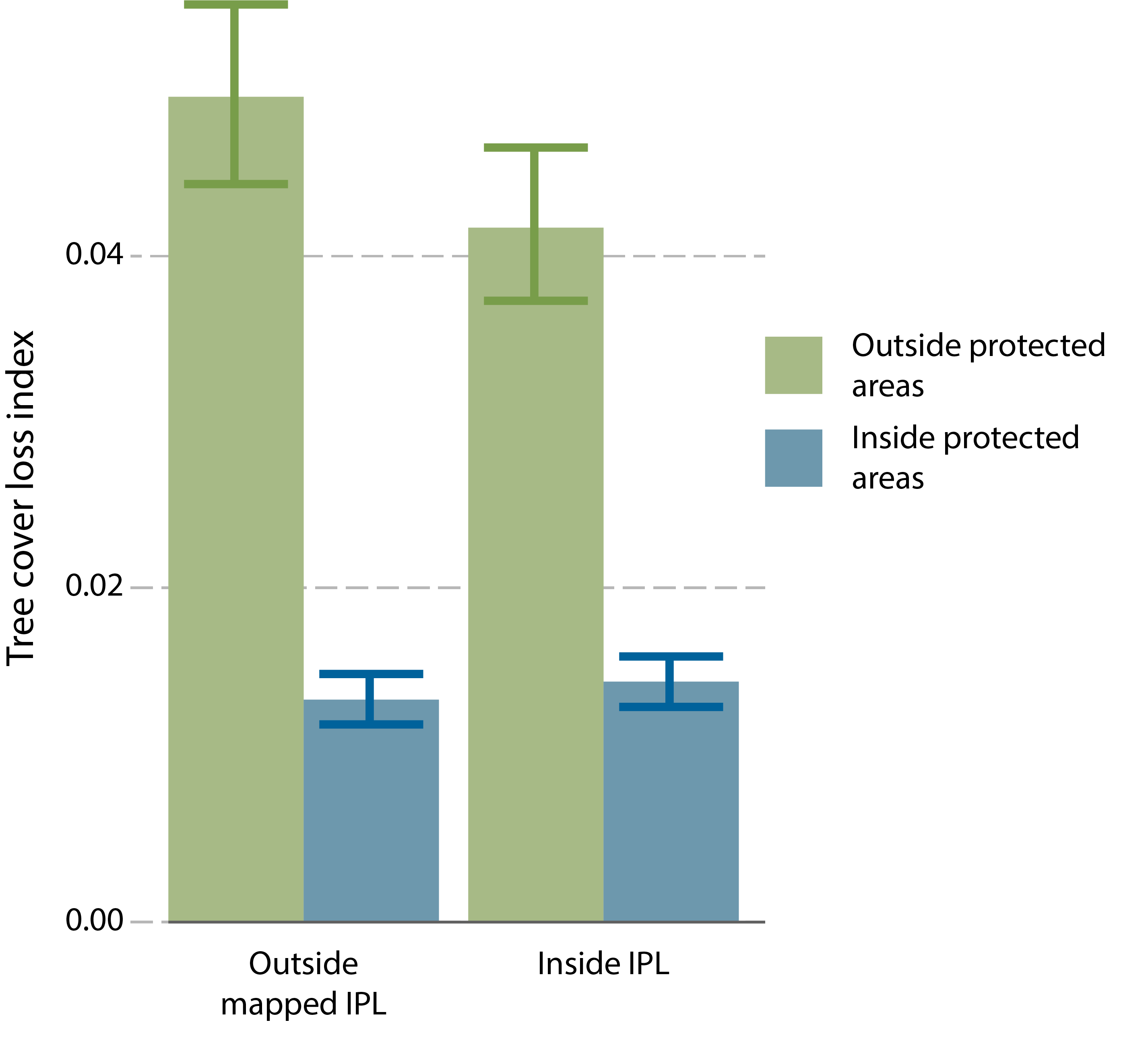
While state-governed protected areas play a critical role in site-based conservation, it is also important to consider the contribution of other governance and management systems. Indigenous Peoples’ Lands cover at least 28% of the land area of Key Biodiversity Areas (KBAs), of which around half currently falls outside of the protected area network. Research suggests that the rate of tree cover loss in KBAs that fall outside of protected areas but within mapped Indigenous Peoples’ Lands is lower than in KBAs that fall outside of both protected areas and mapped Indigenous Peoples’ Lands. This suggests that Indigenous Peoples’ Lands may contribute to conservation of these sites. However, there is significant variation between countries, so more research is needed to understand the factors influencing the ability of Indigenous Peoples’ Lands to have positive biodiversity outcomes.
Site-based conservation is a key component of biodiversity conservation. Through effective management of the most important sites for biodiversity, we not only conserve species, but also the ecosystems they are part of and the services these provide. Key Biodiversity Areas (KBAs) represent a network of >16,300 sites of significance for the global persistence of biodiversity. Formal protected areas play a critical role in conserving these sites—on average, 43.5% of the area of each KBA is covered by protected areas. However, designation of formal state-governed protected areas is not always appropriate or feasible, and protected areas are not always effectively managed. In some cases, biodiversity may be better conserved through long-established sustainable management practices by Indigenous Peoples or local communities.
Indigenous Peoples’ Lands cover at least 38 million km2 (28%) of Earth’s land area (Garnett et al. 2018), including at least 3.73 million km2 (28%) of the total land area of all KBAs (Simkins et al. 2023). Around half of this area currently falls outside of the protected area network. It is therefore possible that Indigenous Peoples’ Lands may contribute significantly to the conservation of KBAs that lack formal protection, but more research is needed to understand biodiversity patterns within these sites.
Simkins et al. (2023) assessed the effectiveness of Indigenous Peoples’ Lands for conserving biodiversity, by comparing rates of tree cover loss in forest KBAs inside and outside of protected areas and mapped Indigenous Peoples’ Lands. They found that overall, tree cover loss was lowest in KBAs within protected areas, regardless of whether they were within or outside mapped Indigenous Peoples’ Lands, suggesting that protected areas are effective at mitigating tree cover loss (although this finding was not universal across all countries included in the analysis). However, outside of protected areas, tree cover loss was lower inside mapped Indigenous Peoples’ Lands than outside mapped Indigenous Peoples’ Lands (see fig. 1). This suggests that Indigenous Peoples’ Lands may be effective at conserving biodiversity outside of protected areas.
Figure 1: Rate of tree cover loss in forest KBAs inside and outside of mapped Indigenous Peoples’ Lands (IPL) and protected areas

Error bars show 95% confidence intervals. Results are from a negative binomial model run on matched locations in KBAs in countries where Indigenous Peoples’ Lands were identified by Garnett et al. (2018). Data from Simkins et al. (2023)
The relationship between the rate of tree cover loss in KBAs and the overlap of these KBAs with protected areas and Indigenous Peoples’ Lands varied significantly between countries. In half of the countries included in the analysis, there was no significant difference in rate of tree cover loss in KBAs inside and outside mapped Indigenous Peoples’ Lands. This variation may be due to a number of factors influencing the ability of Indigenous Peoples’ Lands to mitigate forest loss, including differences in how Indigenous People’s rights, particularly their land ownership and management rights, are recognised and respected in different countries. Further research is needed to understand why tree cover loss was lower in some Indigenous Peoples’ Lands than others, and how Indigenous Peoples’ Lands impact other habitats and species.
Under Target 3 of the Kunming-Montreal Global Biodiversity Framework, the world’s governments have pledged to conserve at least 30% of the planet’s land and sea by 2030 (“30 by 30”), either through designation of formal protected areas or through “other effective area-based conservation measures” (OECMs), while “recognizing and respecting the rights of indigenous peoples and local communities, including over their traditional territories”. The analyses published by Simkins et al. (2023) suggest that Indigenous Peoples’ Lands may provide an important contribution towards meeting this target.
References
Garnett, S. T., Burgess, N. D., Fa, J. E., Fernández-Llamazares, Á., Molnár, Z., Robinson, C. J., Watson, J. E. M., Zander, K. K., Austin, B., Brondizio, E. S., Collier, N. F., Duncan, T., Ellis, E., Geyle, H., Jackson, M. v., Jonas, H., Malmer, P., McGowan, B., Sivongxay, A., & Leiper, I. (2018) A spatial overview of the global importance of Indigenous lands for conservation. Nat. Sustain. 1(7): 369–374
Simkins, A. T., Donald, P. F., Beresford, A. E., Butchart, S. H. M., Fa, J. E., Fernández‐Llamazares, A. O., Garnett, S. T., & Buchanan, G. M. (2024) Rates of tree cover loss in Key Biodiversity Areas on Indigenous Peoples’ lands. Conserv. Biol: e14195
Compiled: 2024 Last updated: 2024
Recommended citation:
BirdLife International (2024)
Indigenous Peoples’ lands may contribute significantly to global biodiversity conservation.
Downloaded from https://datazone.birdlife.org/sowb/casestudy/indigenous-peoples-lands-may-contribute-significantly-to-global-biodiversity-conservation on 22/12/2024